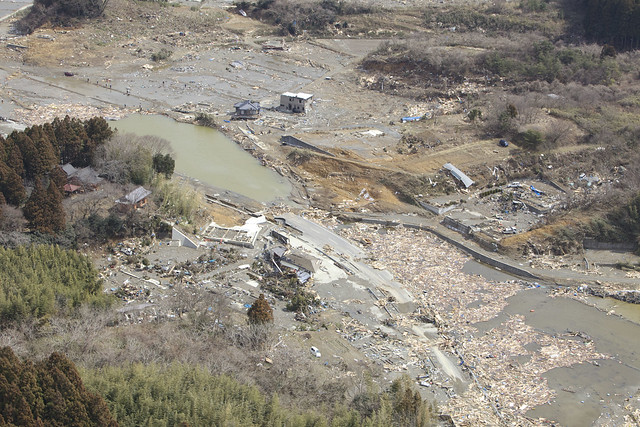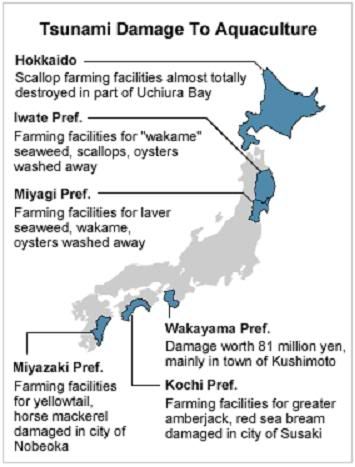
MINATO, Japan (March 18, 2011) An aerial view of Minato, Japan, a week after a 9.0 magnitude earthquake and subsequent tsunami devastated the area. (U.S. Marine Corps photo by Lance Cpl. Ethan Johnson/Released) [source: flickr]
~~~
The WSJ has reported "the United Nations indicated as many as 60,000 acres of agricultural land in several prefectures were damaged" due to the March 11, 2011 tsunami and 9.0 earthquake. Given they have approximately 19,000 square miles of farmland this is equal to one-half percent of their farmland. The Associated Press estimated that at most 8 percent of Japan's 4 million acres (1.6 million hectares) of rice farms might have been affected, or about 4 percent of total rice production. Note that the AP's 320,000 acre estimate far exceeds the UN estimate. The major farmland problem is contamination with debris, saltwater, chemicals and toxins, in addition to radiation surrounding the failing nuclear reactors. From previous events in Indonesia and elsewhere, there is hope that the land will recover and grow rice again quite quickly, within one to two years. Rice growth can be somewhat salt tolerant and it will depend how much water will be washing through the soils, varying by location. Some farms expect richer soils following the tsunami.
A few regions were hit more extremely, such as the strawberry growing region of the northeastern coastal city of Yamamoto Town, which lost 80% of its small strawberry farms and many greenhouses. In Miyagi prefecture which includes Sendai, more than 37,000 acres of farmland was covered in seawater and debris, or about 11% of its total farmland.
From the WSJ regarding Sendai, the city nearest the epicenter:
More than 40% of the farmland of the coastal city of Sendai, for instance, has been soaked with salt water, sludge, cars and garbage. The city is still trying to figure out whether the toxic cocktail has ruined the soil of its rice paddies and wheat fields and if they can be cleansed. "There is debris everywhere," said Tomio Tsuchita, a manager at the agricultural promotion department of the city of Sendai. "Until we start to get rid of that garbage, we cannot even think about using the land again."The clearing of the waste and where to put it are major problems for Japan. Government workers must help clean fields of debris using tractors, trains, testing soil, and possibly bringing in new soil and fertilizer to previously rich vegetable growing areas. Flooding fields and rice paddies with water now would help wash out the salt, but there is no water available in some places. Many farmers are older and will just give up. In Miyagi prefecture the average age of the farmer is over 65. This also raises the concern of adequate clean-up manpower.
Japan's Ministry of Agriculture has reassured people about an adequate rice supply:
As for rice, its production quantity is equivalent to its demand quantity, and there is fully enough private stock.(Private stock estimate on the end of June, just before the first harvest, is 2 million ton.) In addition to the private stock, government has 1 million ton of rice stock which is available any time. Therefore, Japan has enough rice.Four major importing facilities and attached feed mills were damaged. They account for around 15 percent of Japan’s total annual compound feed production of 25 million tons. A fifth large mill was damaged but has partially resumed feed production. Initially following the tsunami, minimal animal loss was expected, but the logistics of fuels, feed and product distribution is problematic in some locations.
But, Goldman Sachs raised concerns that the tsunami and nuclear disaster would put 20% of Japan's meat production at risk including beef, dairy, pig and poultry. Iwate, one of the sites damaged most by the flood, is Japan's third-biggest prefecture by dairy herd, and a major beef and pork producing center.
The NYTs reported that the Fukushima Prefecture has 70,000 farmers and many were threatened by vegetable and milk bans due to scares of radiation:
Japan depends heavily on foreign suppliers for most food, but up to 80 percent of all vegetables are locally grown. Fukushima’s 70,000 commercial farmers produce more than $2.4 billion worth of spinach, tomatoes, milk and other popular foods a year. The government’s ban on produce sales last week stopped that industry — and those in three adjacent prefectures to the south, Ibaraki, Tochigi and Gunma — in their tracks. Across the region, farmers are dumping millions of gallons of milk and tons of ripe vegetables into pits and streams, unable to sell their products legally on the open market. ... “We have no income,” he said, “and the truth is that we don’t want to continue this. All the agriculture is gone. The consumers don’t want to buy products from Fukushima Prefecture, so we can’t sell them. It’s the rumor problem.”There was supposedly one farmer suicide already, following the bans.
Rice planting is to begin in mid-April in Japan, so soil testing is being done to check for radiation and salt, depending upon the location, prior to planting. Rice production in Fukushima and neighboring Ibaraki and Miyagi prefectures amounted to 1.22 million metric tons last year, representing 15 percent of the country’s total output.
From BlackSeaGrain:
The government discovered 163,000 becquerel per kilogram of radioactive cesium and 1.17 million becquerel of radioactive iodine in soil in Iitate village, about 40 kilometers (25 miles) from the plant. The health ministry tentatively set tolerance levels of radioactivity in each food. For grains including rice, the level is set at 500 becquerel per kilogram of cesium and 100 becquerel per kilogram of uranium. Rice may absorb cesium from soil as it grows in paddies for about five months. The ministry must check how much cesium in soil can be transmitted to rice, Yamada said.Fishing and aquaculture were severely impacted by the tsunami, closing many fishing ports and destroying many fish farms. In Iwate, many aqua farms for abalone, sea urchins, oysters, scallops and seaweed were destroyed, which the local government says accounts for 80 percent of the revenue for local fisheries.
From Nikkei.com:
...the Fisheries Agency had received reports of tsunami damage to fish farms in 13 prefectures. Nearly the entire coastline of Iwate, Miyagi and Fukushima prefectures was devastated, and fishermen are struggling to pick up the pieces. In Miyagi Prefecture, farming facilities for "wakame" seaweed, kelp, scallops, oysters and other seafood have been washed out. According to the prefecture's fishery cooperative, almost no oyster facilities are left. ... In Uchiura Bay, which accounts for more than 90% of scallops cultivated in Hokkaido, facilities were almost totally destroyed in some areas. ... Wholesale prices of red sea bream and greater amberjack were already rising before the earthquake, due to surging fish feed costs.Nikkei.com had this excellent graphic map to explain the aquaculture losses and it is impressive to see how far-reaching the damages were:

source: Nikkei.com
___________________________
To read my earlier reports on how agriculture in Japan might be affected by the earthquake and tsunami, see:
- What Effect will the recent Tsunami, Earthquake, and Nuclear Disaster have upon Japan's Agriculture?
- Maps of the Japan Nuclear Reactors, Tsunami, and Farmland Areas
Rather ironically, I made this post about the same time the new 7.3 quake hit Japan (today).